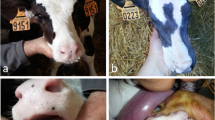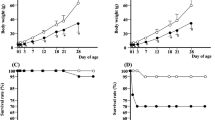Phenotypic and molecular genetic examinations of a transgenic mouse line showing developmental defects caused by a recessive insertional mutation were carried out. The mutant phenotype is characterized by general retardation of postnatal body growth and by the appearance of increased incisor length in the upper and lower jaw. The mutation causing the aberrant phenotype was mapped to Chromosome 13, 40 cM. Examination of the expression of the candidate genes did not show any alterations. This mutant mouse line provides a reproducible model for the identification and examination of gene(s) involved in growth and in the craniofacial development, including that of the jaws and teeth.
Similar content being viewed by others
Author information
Authors and Affiliations
Rights and permissions
About this article
Cite this article
Petznek, H., Kappler, R., Scherthan, H. et al. Reduced body growth and excessive incisor length in insertional mutants mapping to mouse Chromosome 13 . Mamm Genome 13, 504–509 (2002). https://doi.org/10.1007/s00335-002-3006-5
Received:
Accepted:
Issue Date:
DOI: https://doi.org/10.1007/s00335-002-3006-5




